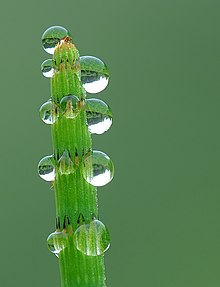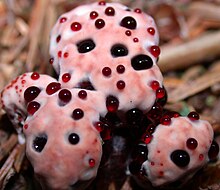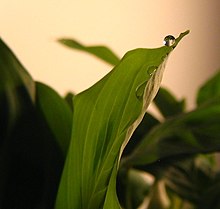Guttation

Guttation is the
Process



At night,
Guttation formation in fungi is important for visual identification, but the process causing it is unknown. However, due to its association with stages of rapid growth in the life cycle of fungi, it has been hypothesised that during rapid metabolism excess water produced by respiration is exuded.[1]
Chemical content
Guttation fluid may contain a variety of organic and inorganic compounds, mainly sugars, and potassium.[2] On drying, a white crust remains on the leaf surface.
Girolami et al. (2009) found that guttation drops from corn plants germinated from neonicotinoid-coated seeds could contain amounts of insecticide consistently higher than 10 mg/L, and up to 200 mg/L for the neonicotinoid imidacloprid. Concentrations this high are near those of active ingredients applied in field sprays for pest control and sometimes even higher. It was found that when bees consume guttation drops collected from plants grown from neonicotinoid-coated seeds, they die within a few minutes.[3] This phenomenon may be a factor in bee deaths and, consequently, colony collapse disorder.
Nitrogen levels
If high levels of nitrogen appear in the fluid, it is a sign of fertilizer burn[citation needed].
See also
- Homeostasis
- Osmosis
- Soil plant atmosphere continuum
